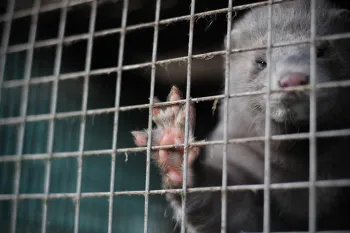BRUSSELS—The European Union has officially added the American mink (Neogale vison) to the list of Invasive Alien Species of Union Concern, in a move that could effectively ban mink fur farming across the EU. However, animal protection charity Humane World for Animals Europe (formerly called Humane Society International) warns mink fur farming could continue unabated if the European Commission allows Member States to issue permits to fur farmers under a derogation, effectively sidestepping the ban.
The charity has written to the Commission urging it not to consider derogation applications until after it publishes its legislative response to a 1.5 million signature European Citizens Initiative petition calling for an EU-wide ban on all fur farming. The Commission has committed to assessing potential legislative action and is expected to table a legislative proposal by March 2026 which could pave the way for an EU-wide fur farming ban.
Dr. Joanna Swabe, senior director of public affairs at Humane World for Animals Europe, says: “Including the American mink on the list of invasive alien species sends a strong message that the ecological and ethical costs of mink farming can no longer be tolerated. It should give Member States a clear legal foundation to shut down mink fur farms. However, there is a risk it could be side-stepped by a handful of countries that persist with fur farming. The European Commission’s priority, therefore, must be to heed the will of over 1.5 million citizens by bringing forward a permanent ban on all fur farming across the EU—for ethical, ecological and animal welfare reasons.”
Under Regulation (EU) 1143/2014, Member States will be required to prohibit the breeding, sale, keeping, transport and release of American mink. Member States will be required to support fur farmers to transition away from the industry through compensation, training and reemployment programmes.
While the regulation could help accelerate the closure of fur farms in countries such as Spain, which has already indicated intent to shut down the industry as part of its biodiversity strategy, others such as Denmark, Greece and Finland could seek to undermine the ban by requesting to continue mink farming under exemptions. When the raccoon dog was added to the IAS list in 2019, Finland and Poland exploited the derogation and were granted an authorisation for 30 years to allow raccoon dog fur farming to continue, despite overwhelming evidence of the ecological threat posed.
Dr. Swabe continues: “Given that a Union-wide ban on fur farming could soon be on the horizon, Humane World for Animals Europe urges the European Commission not to grant authorizations for Member States to issue permits to fur farmers to allow mink farming to continue until the Commission’s legislative response to the ECI is clear. Granting authorization now would not only subvert both the spirit and intent of EU environmental law, but would also see fur farms commence costly infrastructure upgrades—such as installing fencing and surveillance—which makes no sense for a dying industry in financial freefall. This could waste public funds, prolong animal suffering and perpetuate ecosystem damage. We urge the Commission not to prolong the fur trade’s demise and the misery it causes to animals.”
Facts about American mink in Europe
-
Originally native to North America, the American mink was introduced to Europe in the early 20th century for fur farming and, in some cases, deliberately released for hunting. Over time, millions of mink escaped from farms, establishing feral populations in the wild that now pose a threat to native waterbirds, amphibians, small mammals and fish as well as the critically endangered European mink, contributing to its decline.
-
As of 2024, despite falling demand for fur and rising public opposition, around 6 million American mink were still kept in captivity on EU fur farms in countries such as Poland, Spain, Finland and Greece although the industry in these countries is in steep decline. Twenty-two European countries, including 16 Member States, have already banned fur farming, including Estonia, Latvia, Lithuania and Romania; there are no more active fur farms in Sweden.
-
Following the successful Fur Free Europe European Citizens’ Initiative, the European Commission committed to assessing potential legislative action to phase out fur farming. The process is currently advancing along the following key milestones: a Call for Evidence is expected in summer 2025 which will allow all concerned parties—including citizens, NGOs, industry and Member States—to submit views on the potential content, scope and impact of a legislative proposal. The European Food Safety Authority is due to publish its scientific opinion on the welfare of animals farmed for fur in mid-July 2025. Based on this input, the Commission is expected to table a legislative proposal by March 2026, which could pave the way for a ban on both fur farming and the placement of farmed fur products on the EU market.
ENDS
